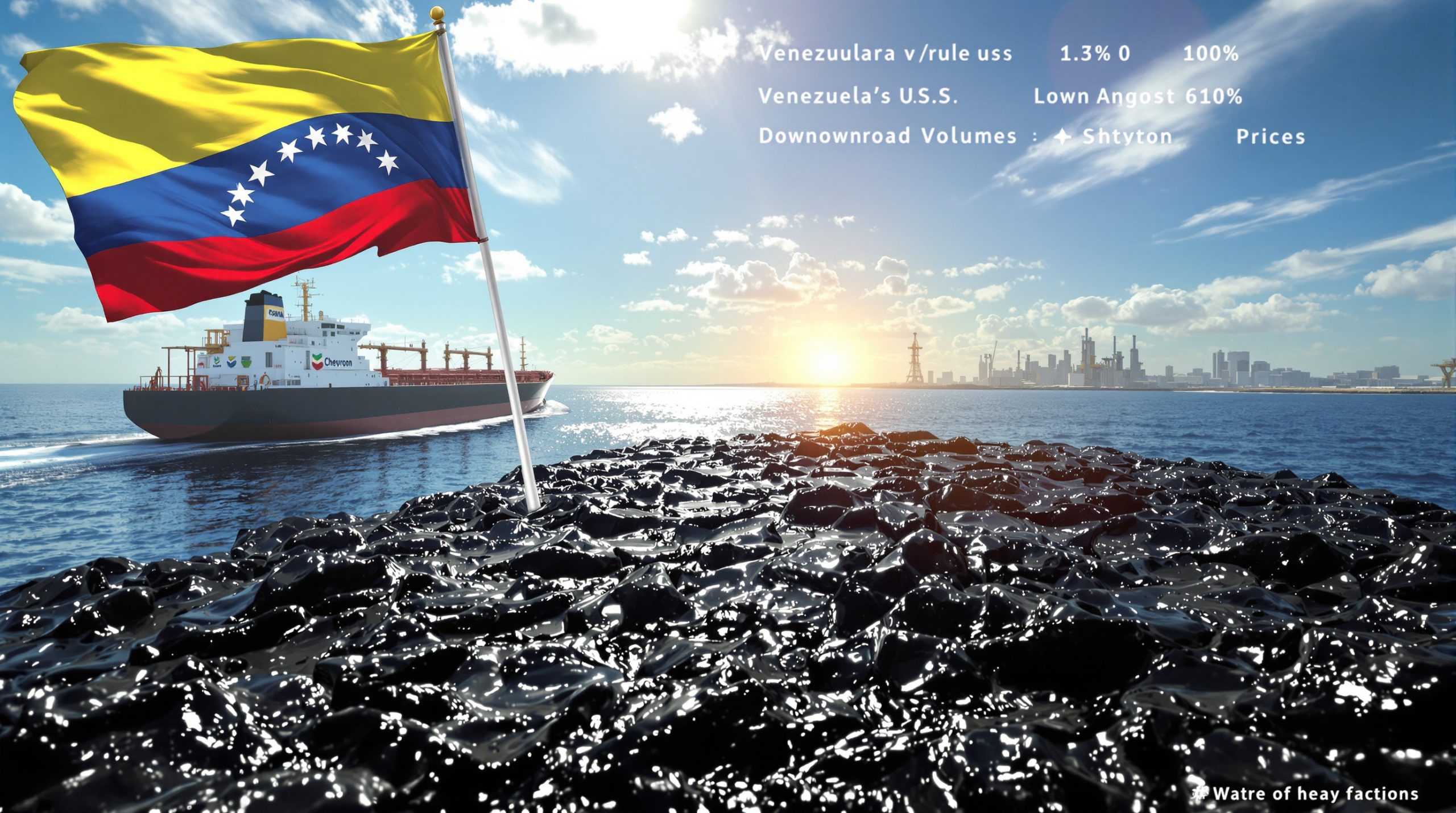Understanding Crude Oil Prices Today: Market Dynamics and Trends
Crude oil prices have exhibited significant volatility in recent trading sessions, with West Texas Intermediate (WTI) crude rising to $59.49 per barrel (a 4.13% increase) and Brent crude reaching $62.49 (a 3.75% gain) as of the latest market update. This rebound follows a period of downward pressure, highlighting the market's resilience amid evolving supply-demand dynamics and geopolitical uncertainties. The price recovery suggests investor confidence in underlying demand fundamentals, even as OPEC+ accelerates production increases. Key factors influencing current crude oil prices today include geopolitical tensions in the Middle East, revised forecasts from major financial institutions, and structural shifts in U.S. shale production.
How Are Crude Oil Prices Performing Today?
The current crude oil prices today demonstrate remarkable resilience following recent market challenges. With WTI and Brent crude both posting gains above 3.7%, traders appear to be shrugging off concerns about increased OPEC+ production quotas, focusing instead on underlying demand strength and geopolitical risk factors.
Latest Price Movements in Major Oil Benchmarks
The current oil market features divergent trends across energy commodities. While crude benchmarks show strong gains, natural gas prices have declined by 2.39% to $3.465/mmBtu, reflecting sector-specific demand variations. The table below details recent price changes:
| Commodity | Price | Change ($) | Change (%) |
|---|---|---|---|
| WTI Crude | $59.49 | +2.36 | +4.13% |
| Brent Crude | $62.49 | +2.26 | +3.75% |
| Murban Crude | $62.77 | +2.81 | +4.69% |
| Natural Gas | $3.465 | -0.085 | -2.39% |
| Gasoline | $2.072 | +0.050 | +2.45% |
Source: Oilprice.com market data
The 4.69% surge in Murban crude prices—a key Asian benchmark—signals strong regional demand, particularly from refining centers in China and India. Conversely, the natural gas downturn reflects reduced heating demand and increased inventory levels in North America.
What Factors Are Driving Today's Oil Price Recovery?
Analyzing crude oil prices today requires understanding multiple factors contributing to the recent market resilience, from OPEC+ decisions to geopolitical developments and fundamental demand indicators.
OPEC+ Production Decision Impact
OPEC+ stunned markets by announcing a 500,000 barrel per day production increase, exceeding analysts' expectations by 40%. Despite initial concerns about oversupply, prices rebounded within 48 hours, indicating the market had largely priced in the decision. This response underscores traders' belief that global demand growth—projected at 1.8 million barrels per day for 2025—will absorb the additional supply. The group's revised output strategy marks a departure from its previous supply management approach, suggesting confidence in maintaining market dynamics explained.
Global Demand Indicators
Asian refiners have capitalized on recent price dips, with Chinese independent refiners increasing purchases by 22% month-over-month. This opportunistic buying behavior has created a demand floor near $58/bbl for WTI. The International Energy Agency (IEA) reports global oil inventories have drawn down to 97% of five-year averages, providing fundamental support for crude oil prices today.
Geopolitical Tensions and Supply Concerns
Ongoing tensions surrounding Iran's nuclear program have added a $3-$5/bbl risk premium to crude prices. Recent attacks on Iranian power infrastructure have raised concerns about potential retaliation affecting Strait of Hormuz shipping lanes, through which 21 million barrels of oil transit daily. These developments counterbalance the bearish pressure from increased OPEC+ supply.
How Have Major Financial Institutions Adjusted Their Oil Price Forecasts?
Financial analysts continue revising their outlook for crude oil prices today in response to evolving market dynamics and economic indicators.
Recent Forecast Revisions
Morgan Stanley revised its Brent crude forecast downward to $62.50/bbl, citing "persistent non-OPEC supply growth and demand risks from China's property sector slowdown." Goldman Sachs followed with a 7% reduction in its 2025 price target, projecting Brent will average $65/bbl. These adjustments reflect growing concerns about global economic headwinds, particularly the impact of U.S.-China trade tensions on manufacturing activity.
Factors Behind Forecast Adjustments
-
OPEC+ Supply Increases: The accelerated production timeline introduces 150 million additional barrels to markets in Q3 2025.
-
U.S. Shale Resilience: Despite predictions of peak production, Permian Basin output rose 2.1% in April to 6.45 million bpd.
-
Economic Slowdown: The IMF's revised global GDP growth forecast of 2.9% for 2025 (down from 3.2%) suggests moderate demand growth.
What Is OPEC+ Doing to Manage Oil Supply?
OPEC+ strategies continue to shape crude oil prices today through production decisions and pricing policies that signal their market outlook.
Saudi Arabia's Pricing Strategy
Saudi Aramco raised its July Official Selling Price (OSP) for Asian customers to a $4.80/bbl premium over Dubai/Oman benchmarks—the highest since November 2023. This counterintuitive move (increasing prices while boosting production) signals confidence in Asian demand stability. Analysts interpret this as an attempt to maximize revenue ahead of potential market softness in late 2025.
Impact on Market Balance
The group's production increases will test the market's absorption capacity. Current projections suggest global inventories could build by 1.2 million bpd in Q3, potentially capping price gains above $65/bbl. However, OPEC+ has retained its "circuit breaker" mechanism allowing rapid production cuts if prices fall below $55/bbl.
How Are Major Oil Companies Responding to Price Volatility?
Major energy corporations are adapting their strategies to navigate the fluctuating crude oil prices today while balancing shareholder returns with future investments.
Dividend and Investment Strategies
ExxonMobil maintained its $3.80/share quarterly dividend despite a 12% year-over-year earnings decline, underscoring commitments to shareholder returns. Concurrently, the company announced a $17 billion capital expenditure program focused on low-carbon projects and Guyana deepwater development. This dual approach reflects the industry's balancing act between current profitability and energy transition pressures, which is increasingly relevant as net-zero myths are scrutinized.
Quarterly Performance Indicators
-
ExxonMobil: Permian Basin production reached 620,000 bpd (+15% YoY), offsetting weaker downstream margins.
-
Chevron: Refining margin recovery contributed $1.2 billion to Q1 earnings, despite $650 million in write-downs on renewable energy investments.
-
Shell: Continued share buybacks of $2.75 billion for Q2, funded by strong LNG trading performance.
What Role Does U.S. Production Play in Current Oil Markets?
U.S. production trends significantly impact crude oil prices today, with signs of peaking output potentially shifting global supply dynamics.
U.S. Production Outlook
Pioneer Natural Resources CEO Scott Sheffield recently stated, "We're approaching peak Permian output within 18-24 months due to tier-2 inventory quality concerns." This assessment aligns with EIA projections showing U.S. production growth slowing to 300,000 bpd in 2025, down from 900,000 bpd in 2023.
Policy Considerations
The House Energy Committee's proposed "Federal Lands Production Act" aims to accelerate drilling permit approvals by 40%, potentially adding 500,000 bpd by 2027. However, these measures face opposition from environmental groups and are unlikely to impact near-term supply dynamics. The industry continues to monitor potential impacts of Trump's energy policies on future production.
How Are Global Economic Factors Influencing Oil Prices?
Economic conditions in key markets continue to shape demand patterns and influence crude oil prices today through complex market relationships.
Chinese Demand Signals
Despite a 9% year-over-year increase in crude imports, China's refined product exports surged to 1.8 million bpd in April—a 34% increase—indicating weaker-than-expected domestic demand. This divergence suggests the world's largest oil importer may become a net exporter of refined fuels, creating downstream market pressures.
Global Growth Forecasts
The IMF's 0.7 percentage point reduction in Middle Eastern growth projections (to 2.1% for 2025) reflects the fiscal strain on oil-dependent economies like Saudi Arabia, which requires $81/bbl Brent to balance its budget. This creates incentives for continued OPEC+ production discipline despite formal quota increases. For investors seeking to understand broader implications, analysis of global commodities insights can provide valuable context.
What Are the Technical Price Support and Resistance Levels?
Technical analysis provides important insights for traders attempting to anticipate movements in crude oil prices today.
Key Price Thresholds
Technical analysts identify critical levels:
- WTI: Strong resistance at $61.50 (200-day moving average), support at $56.80 (April low).
- Brent: Fibonacci retracement level at $64.20, with put option concentrations below $58 signaling downside protection demand.
Open interest in WTI futures has increased 18% since the OPEC+ announcement, suggesting heightened speculative activity.
What's the Outlook for Crude Oil Prices?
Looking ahead, multiple factors will determine the trajectory of crude oil prices today and in coming months.
Short-term Projections
Q3 2025 prices will likely oscillate between $58-$65/bbl Brent, influenced by:
- OPEC+ compliance rates with new quotas
- Atlantic hurricane season impacts on Gulf Coast refining
- Progress in U.S.-China trade negotiations
Long-term Structural Considerations
The potential peaking of U.S. shale output and underinvestment in conventional projects (upstream CAPEX remains 25% below 2014 levels) suggest tighter markets post-2026. This structural deficit could push prices above $80/bbl by 2028 without significant investment increases. Additionally, new Middle East investment trends could significantly impact future supply scenarios.
FAQ: Understanding Today's Oil Market
Why did prices rebound post-OPEC+?
The market had priced in larger increases during previous sessions. Fundamental demand strength, particularly from Asian buyers, provided support for crude oil prices today.
How do U.S. policies affect markets?
Proposed drilling incentives are long-term measures unlikely to impact 2025 supply. Current prices reflect Trump administration policies favoring energy exports.
What would drive prices above $70?
Escalation in Middle East conflicts disrupting Strait of Hormuz traffic or faster-than-expected demand recovery in Europe could push crude oil prices today significantly higher.
This comprehensive analysis demonstrates the complex interplay of market fundamentals, geopolitical risks, and structural shifts shaping crude oil prices. Continued monitoring of OPEC+ compliance, U.S. production trends, and global economic indicators remains essential for understanding near-term price trajectories.
Ready to Get Instant Alerts on the Next Oil Price Shift?
Stay ahead of volatile oil markets with Discovery Alert's proprietary Discovery IQ model, delivering real-time notifications when significant market-moving announcements occur. Visit our discoveries page to see how our subscribers capitalise on market movements before the crowd.




